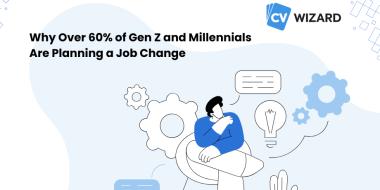Different Types of Resumes: Choose What’s Right for You
Your resume is a document that represents you as an individual, so it should accommodate your role, industry, and unique skills. This means that one resume format doesn’t suit everyone – which is why there are so many to choose from. In this guide, we discuss the top five types of resumes, who they’re best for, and when to use each one.

The 5 best types of resume formats
Not all resumes are the same. Choosing the right resume structure enhances your application and shows the hiring manager your relevance to the role. Some resumes are better for traditional full-time jobs, while others are perfect for freelance creatives.
Here’s a brief description of the five main types of resumes:
- Reverse chronological: Lists work experience and education starting with the most recent, impactful additions and goes backward from there.
- Functional: Leads with your skills and how you apply them, rather than work history. Perfect for people changing careers.
- Mixed: A combination of a reverse chronological and functional resume, leading with your skills but then discussing your work history.
- Creative: Showcases creative abilities in unique ways, such as through a video resume or testimonials.
- Infographic: A graphic resume that showcases colors, typefaces, and design skills.
Now, let’s discuss each one in-depth, including when you should use each one.
1. Reverse chronological resume
A reverse-chronological resume, also called a chronological resume, lists work experience, education, and achievements starting with the most recent events and works backward from there. This structure is one of the most popular types of resume format.
Placing your most recent achievements at the top puts your most relevant information right in front of the hiring manager’s eyes so they don’t have to look too hard. For example, a professional’s most recent experience is in a sales manager role, so the recruiter wants to see that before they read about their years as a junior sales associate.
Here’s an example of a reverse-chronological Work Experience section for an HR manager:
HR Manager
Clean Solutions, Boulder, CO
January 2020 – August 2024
- Implemented a new ATS system, streamlining the company hiring process and improving hiring speed by 30%.
- Introduced modern interviewing techniques, expertly vetting job candidates and leading to a 15% increase in quality of hire.
HR Specialist
Westley Consultation, Lafayette, CO
December 2017 – November 2019
- Managed recruitment and onboarding for a three-month period, handling over 100 employees.
- Practiced excellent relationship management, building trust between managers and employees.
We recommend the reverse chronological resume to most job seekers as it applies to nearly every situation, including traditional full-time jobs and many freelance positions.
2. Functional resume
A functional resume is skills-based, focusing on abilities and competencies rather than work experience. This resume starts with skills and places them in bold headers, like Work Experience entries. Underneath each header, add a bullet list of achievements you earned using that skill.
Functional resumes use the main types of skills for resumes, both hard and soft. However, it’s a little more popular to focus on hard skills.
These resumes are ideal for people with little work experience, like professionals changing their careers. Functional resumes allow these workers to focus on the importance of their skills rather than draw attention to a lack of experience.
This shows the hiring manager that while a food service attendant lacks traditional customer service experience, they have all the right transferable skills to complete the job successfully.
Although this resume is quite different than a reverse chronological resume, they’re easy to make with a flexible resume template that lets you create your own sections and add bullet points.
“Choosing the right resume structure enhances your application and shows the hiring manager your relevance to the role.”
3. Mixed resume
The mixed resume, also known as the combination resume, is a blend of the previous two structures. This resume places your most important skills at the top, like a functional resume, but follows that section up with a typical, reverse-chronological Work Experience section.
These documents are excellent for career changers and recent graduates with a small amount of related experience. For instance, a graduate who has six months to a year of internship experience in the same industry.
Another example is a professional shifting from sales to marketing. Although it isn’t strictly relevant, a history in sales shows the recruiter you have experience talking with clients and discussing terms and requirements.
However, they’re also excellent for professionals with only one to three years of experience—even if you have relevant work experience, adding your skills and associated achievements helps you stand out from the crowd.
4. Creative resume
Creative resumes are nontraditional resumes that showcase creative abilities like graphic design, editing, and copywriting. They typically strike a balance between displaying personality and maintaining professionalism.
These resumes show skills rather than talk about them. By displaying your skill in real examples throughout the document, they aim to catch the hiring manager’s eye and make you stand out.
Here are a few popular options for creative resumes:
- Video resumes: A quick video where you discuss your achievements. This creative resume shows off production and editing abilities.
- Portfolio resumes: Resumes that contain links to published written work and websites, giving the recruiter an easy way to browse real examples.
- Testimonial resume: Placing real quotes from previous colleagues and clients shows the hiring manager the opinions of others, essentially providing them with a quick reference.
5. Infographic resume
A step beyond the creative resume is the infographic resume. This resume is a graphic containing engaging elements like icons, timelines, graphs, and statistics. Certainly eye-catching, this resume isn’t for everyone – it’s nearly exclusive to graphic designers.
Graphic-type resumes provide designers an excellent opportunity to prove their abilities to the hiring manager and make a great first impression. Recruiters are likely to remember the candidate who submitted the visually stunning resume with the custom-made resume photo.
When using this format, it’s important to keep in mind what type of company you’re applying to. Applicant tracking systems may not be able to read infographic resumes, which puts your resume at risk of being tossed aside. If you want to be sure, use this structure when applying to smaller companies and startups that might not be using an ATS.
How to choose the right resume format
Different resumes are best for different professionals, so how do you choose the best one for you? Here are our top tips:
- Consider the stage of your career: Are you a junior, senior, or a recent graduate? Your career level matters, as seasoned professionals lean toward chronological resumes, but junior level and students benefit from functional and mixed resumes.
- Think about industry norms: Look at other professionals in your industry to see what’s typical. Many corporate roles use chronological resumes, but graphic designers and editors love creative video resumes.
- Keep in mind your personal preferences: Always consider your own preferences. Hiring managers love a candidate with personality, and choosing a resume you resonate with makes you stand out.
- Consider the specific job application: Some resumes are best for certain occasions. Read the job description for more insights – you might find that the employer you’re targeting is quirky and fun-loving, so they’d love an infographic resume. Studying the job description also tells you which types of skills to put on resumes, making it a valuable strategy.
We encourage you to experiment with different resumes and discover what works best for your unique circumstances and professional goals. Browse our resume samples for more realistic examples and inspiration.
Expert Tip:
Consider different types of resumes for different situations
There’s a reason there are so many types of resumes: they’re all useful in their own ways in different scenarios. Consider your situation before you choose – you might want to use multiple formats, depending on the application. Just keep our tips in mind:
- Reverse chronological is the most common resume, popular with full-time positions
- Functional resumes are best for recent graduates and professionals changing careers
- Mixed resumes are ideal for professionals with a bit of experience but not much
- Creative resumes are perfect for editors, writers, and designers eager to show their skills
- Infographic resumes display graphic design talent and make you stand out
Head over to CVwizard’s resume maker and start experimenting with different types of resumes. You might not know what’s right for you until you try it out.
Make an impression with your resume
Create and download a professional resume quickly and easily



